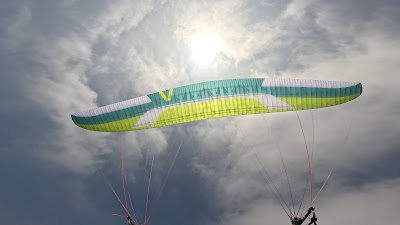Disclaimer:
Please note again… that tests will always differ with other sizes. At first, if flown with seatless harnesses, or must I say a completely different harness. Also if the same sizes are flown at different loads, lighter loads will get the weakest climb but will be penalized in control in heavy air or pushing through a heavy airmass. Bigger sizes have more gliding performance and also better climb in weak conditions. In my small tests, I always state the size, the total flying weight, and afterward IMHO, the optimum weight I found in that particular glider.
FLOW XC racer 2 S 75-95
The latest 2-liner EN-D from FLOW for 2023-24…arrived to replace the old XC Racer 1.
I have over here the S size which goes from 80-95 and I flew it from 92 to 94, 95 all up. The optimum weight for all conditions seems at the end of its weight range, 94, 95.
The construction is pretty nice, with all plastic rods from top to bottom.
The thing with almost all 2 liners, is when having plastic rods all along the glider, the wind will flip the trailing edge at the takeoff.
Launching the Xc Racer 2 with all its plastic rods and complex structure, is fairly easy for that class. I think it resembles the Zeno 2 in that matter. No hard point, just a steady pull, and the takeover is immediate.
In the air, I was surprised but the high level of brake authority and agility of that EN-D glider. I think the XC Racer 2 is the most agile of all the tested 2 liners so far.
The brake travel is short with only 10…15 cm to steer the glider in all conditions! and the brake pressure is moderate and with a nice linear feel, it turns really quickly in thermals for a 7 AR glider and I felt that it is more agile even than some new C 2 liners! A real pleasure to fly it and I am very satisfied by this excellent feel and turning abilities!
Even if conditions were rough, the authority on the brakes let you re-direct the glider inside a turbulent core! A real pleasure underneath that glider!
I flew next to my friend on a Zeno 2 MS @ 96 all up, and also with another friend on his Boom 12 size M that needs slightly a re-trim because it seems slightly slow at trim. We flew together for about 4 hours in difficult air and sometimes turbulent cores. After a while, I can say that the internal and whole structure of the XC Racer 2 felt very solid, and in those ugly conditions, it retained its homogeneity. The level of overall comfort is slightly better than the Zeno 2, just because the brakes give the active and keen pilot a much better authority to re-adjust it swiftly over his head and for me, this is a feature that gives the good pilot a higher safety feel.
Climbing next to those excellent gliders, the Boom 12 in M size of course had a clear climbing easiness, then came the Zeno 2 which bites more aggressively the rising airmass, especially on windy days.
The XC Racer 2 has a neutral pitch before hitting a climb, then when inside it, it surges promptly through it, as it shows you where the strongest core is.
It is slower to enter but still climbs quite well due to the handling capabilities that enable it to place accurately inside a very small core.
At the end of the day, the climb in very weak thermals that are less than 1 m/s, is moderate for that size flown at 95 all up.
Gliding with a speed bar smoothens the glider reactions a bit, and the B controls with a moderate pressure and efficient feel, can control the overall movements while keeping your foot locked on the bar.
The overall movements in nasty air make the XC Racer 2 move a lot from other pilots' perspectives flying next to it. They said that the tips move a lot in those rowdy air, while the Zeno 2 move more as a whole block. But underneath the XC Racer 2, I felt it was quite comfortable to fly. Flying in those tough conditions, and passing by some Lee side turbulent areas, the B12 suffered from a large asymmetric that my friend handled very well. The XC racer 2 just a few meters away made excessive span movements without any collapse and sensed an overall solid structure under the XC racer 2.
We made lots of glides altogether, and I think at trim, half bar, and full bar, both the XC Racer 2 and the Zeno 2 are very close, even at full speed! I think the XC Racer 2 has a very high top speed which tops near 63 km/h and still with a very competitive glide angle and still a solid leading edge.
Ears with A’s are stable, they reopen with pilot intervention, ears with outer B’s are efficient, and reopen quickly. A lot of energy is present while doing wingovers! like an acro glider with steroids!
The stall point is far and feelable. The XC Racer 2 can be slowed quite well even loaded.
Conclusion:
A real piece of a machine with lots of pleasurable handling! The overall performance is on top of that category.
The XC Racer 2 is such a beauty and awaits your invitation to take her on long XCs and competitions.





























